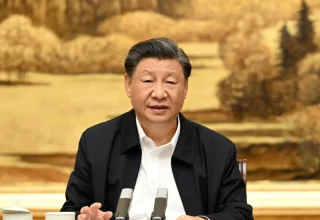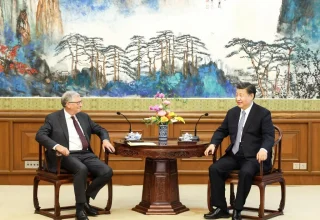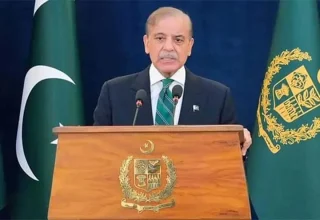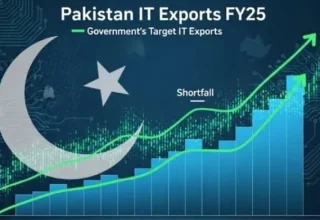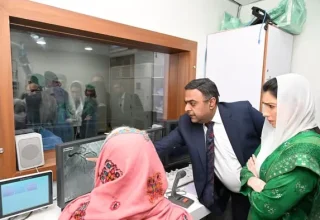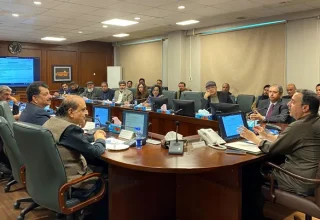
The 70-minute commemorative event and military parade marking the 80th anniversary of the victory of the War of Resistance Against Japanese Aggression and the World Anti-Fascist War at sun-bathed Tian’anmen Square on September 3 set new viewership records. Live broadcasts notched up 29.6 billion cumulative views, aired on more than 2,000 media outlets across 129 countries.
It was a solemn tribute to the sacrifices of martyrs during World War Two and a reflection on China’s pivotal role in safeguarding global peace.
President Xi Jinping emphasized China’s commitment to peace, highlighting both its military modernization and the vision for a harmonious global future. A common thread emerged from international media outlets and scholars: China’s growing military power is seen less as a threat and more as a stabilizing force in an increasingly turbulent world.
A call for peace and rejuvenation
Xi spoke of peace, historical reflection, and China’s unstoppable path toward national rejuvenation. Emphasizing the historical role of China in its 14-year-fight against Japanese aggression and fascism, he described the war of resistance as a “complete victory” under the banner of a national united front established at the initiative of the Communist Party of China. This victory, he stressed, was not China’s alone, but a significant contribution to the global fight against fascism.
Xi also outlined the core principles that will guide China’s future: peace over war, dialogue over confrontation, and cooperation over zero-sum competition. China would continue its path of peaceful development and seek to build a community with a shared future for humanity. The Chinese military – now a modern, world-class force – exists not to pursue aggression, but to defend China’s sovereignty and promote international stability.
A military parade of innovation and modernization
The parade that followed demonstrated the transformation of the Chinese armed forces from a “millet-and-rifle” army – a historical reference to the presence of a large number of farmers in the Chinese army during the war – to a stronger, smarter and more modern military.
More than 10,000 soldiers and over 100 aircraft participated, while hundreds of ground armaments were showcased, all organized under a wartime command system.
From next-generation armored equipment to cutting-edge unmanned systems and upgraded, nuclear-armed missile with global strike capability, the event sent a powerful signal: China is embracing a high-tech path to military modernization.
A newly restructured force, coming into being after the “4 services + 4 arms” military reform, was on full display. The “4 services” are the Army, Navy, Air Force, and Rocket Force; the “4 arms” are the Aerospace Force, Cyberspace Force, Information Support Force, and Joint Logistic Support Force. This reflects China’s evolving defense strategy, which now emphasizes technology and information warfare alongside traditional military capabilities.
The advanced unmanned combat systems were of particular interest. Divided into land, sea, and air formations, they showcased China’s transition to intelligent and autonomous warfare.
One of the most striking moments was the display of China’s strategic nuclear triad. For the first time, China revealed all three components of its nuclear force: missiles launched from land, sea and air.
The JL-1 (Jinglei-1) air-based long-range missile, and JL-3 (Julang-3) submarine-launched intercontinental missile were featured alongside land-based intercontinental missiles the DF-31 and DF-61. The parade culminated with the unveiling of the DF-5C, China’s newest liquid intercontinental ballistic missile with global strike capability.
The powerful display underscored China’s emergence as a nuclear power with full global reach, committed to safeguarding its sovereignty and deterring potential aggression.
But the impressive show of strength was not merely about power. It carried a message of peace and defense – values Xi emphasized in his speech – and that message was noted outside China.

The nuclear missile formation at the military parade in Beijing, China, September 3, 2025. /Xinhua
Global affirmation of China’s peaceful development
The global response to China’s 80th V-Day Parade echoed common themes: remembrance of history, appreciation of China’s modernization, and recognition that military strength can coexist with a commitment to peace.
Evgenii Pavlov of Russian news agency Sputnik called the parade “fantastic.” He emphasized China’s technological edge – “In some areas, it’s definitely in the first ranks and maybe even leading” – indicating that China’s innovation is being acknowledged by major powers.
Christian Blondel Ndongo Abia from Cameroon Radio Television viewed the event not as a show of force but as reassurance. “China is a peace promoter. The army is a factor of peace promotion,” he said, framing modernization as a stabilizing force.
Similar sentiments came from Tihomir Plamenov, a journalist with the Bulgarian National Television, who stressed, “Remember the history, remember the victims,” placing commemoration above confrontation.
Others highlighted the geopolitical dimensions. Spanish journalist Sergi Lara linked the parade to the shifting global balance. For him, readiness was not aggression but deterrence: “No one wants war, but China is prepared if necessary.”
From Pakistan, Zamir Assadi underscored the contrast between China’s intentions and Western portrayals: “The V-Day military parade was not an attempt to frighten people … it was a tribute to the past … and a renewal of the Chinese promise of peace.”
Australian scholar Warwick Powell echoed this by pointing to the U.S. bases in Asia, arguing that “when Western commentators speak of China’s military modernization ‘increasing pressure’ … they conveniently forget” these realities. He described the PLA’s modernization as a game-changer: “It demonstrates that China is more than capable of defending itself … The U.S. can no longer claim this mantle.”
Middle Eastern and Turkish commentators emphasized strategy and unity. Mahnaz Abdi of Tehran Times called Xi’s words “a calculated move in strategic communications … weaving together messages of military strength, diplomatic stance, and historical narratives for both domestic and international audiences.”
Türkiye’s Ozgur Altinbas, chief of foreign news service at the Aydinlik newspaper, stressed the civil-military integration: “A strong army is the greatest guarantee of peace … China has shown that it cannot be bullied by anyone thanks to its strong army and united people.”
From South Africa, Lance Witten drew a sharp contrast between Chinese and Western leadership: “Where Western leaders … preach nationalism and division … Xi preaches multilateralism, shared values, global development and modernization. This is inspirational to me as a citizen of a proudly BRICS-aligned nation.”
Taken together, these reflections from across continents, languages, and political systems send a unified message: True strength lies not in aggression but in fostering cooperation, defending peace, and preventing history’s mistakes from being repeated. For China, the V-Day commemoration thus became more than a national moment. It was a stage to project a message of historical responsibility, strategic confidence, and global partnership.
As the world moves forward, it is essential to listen to this message, recognize the value of peaceful coexistence, and find common ground in pursuing a more just and balanced global order.
Credit to Xu Yawen



